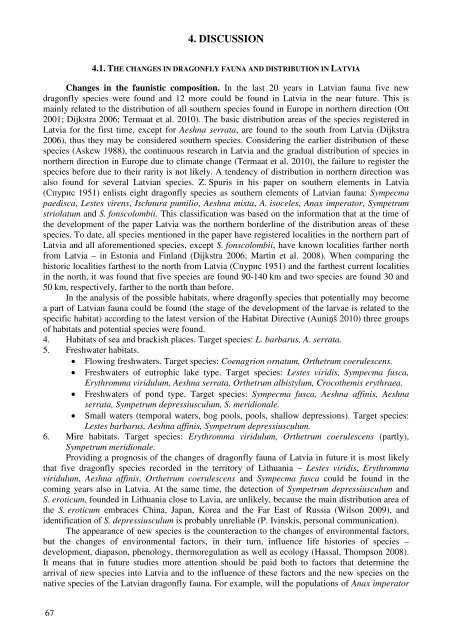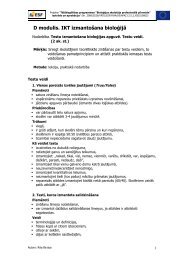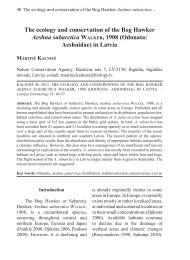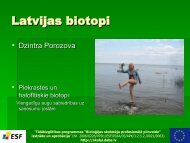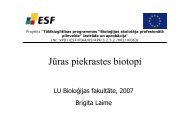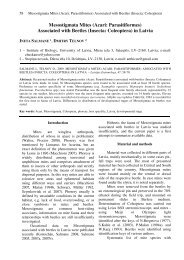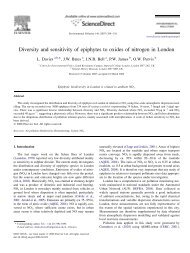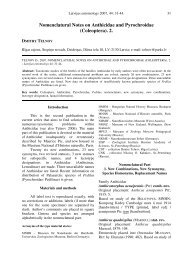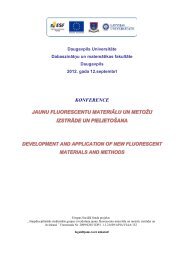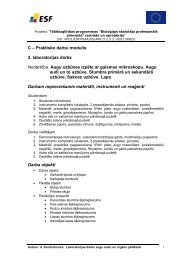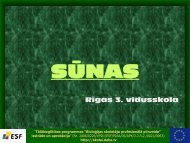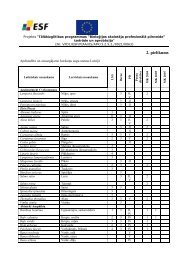Odonata - Entomological Society of Latvia - Latvijas Daba
Odonata - Entomological Society of Latvia - Latvijas Daba
Odonata - Entomological Society of Latvia - Latvijas Daba
You also want an ePaper? Increase the reach of your titles
YUMPU automatically turns print PDFs into web optimized ePapers that Google loves.
4. DISCUSSION<br />
4.1. THE CHANGES IN DRAGONFLY FAUNA AND DISTRIBUTION IN LATVIA<br />
Changes in the faunistic composition. In the last 20 years in <strong>Latvia</strong>n fauna five new<br />
dragonfly species were found and 12 more could be found in <strong>Latvia</strong> in the near future. This is<br />
mainly related to the distribution <strong>of</strong> all southern species found in Europe in northern direction (Ott<br />
2001; Dijkstra 2006; Termaat et al. 2010). The basic distribution areas <strong>of</strong> the species registered in<br />
<strong>Latvia</strong> for the first time, except for Aeshna serrata, are found to the south from <strong>Latvia</strong> (Dijkstra<br />
2006), thus they may be considered southern species. Considering the earlier distribution <strong>of</strong> these<br />
species (Askew 1988), the continuous research in <strong>Latvia</strong> and the gradual distribution <strong>of</strong> species in<br />
northern direction in Europe due to climate change (Termaat et al. 2010), the failure to register the<br />
species before due to their rarity is not likely. A tendency <strong>of</strong> distribution in northern direction was<br />
also found for several <strong>Latvia</strong>n species. Z. Spuris in his paper on southern elements in <strong>Latvia</strong><br />
(Спурис 1951) enlists eight dragonfly species as southern elements <strong>of</strong> <strong>Latvia</strong>n fauna: Sympecma<br />
paedisca, Lestes virens, Ischnura pumilio, Aeshna mixta, A. isoceles, Anax imperator, Sympetrum<br />
striolatum and S. fonscolombii. This classification was based on the information that at the time <strong>of</strong><br />
the development <strong>of</strong> the paper <strong>Latvia</strong> was the northern borderline <strong>of</strong> the distribution areas <strong>of</strong> these<br />
species. To date, all species mentioned in the paper have registered localities in the northern part <strong>of</strong><br />
<strong>Latvia</strong> and all aforementioned species, except S. fonscolombii, have known localities farther north<br />
from <strong>Latvia</strong> – in Estonia and Finland (Dijkstra 2006; Martin et al. 2008). When comparing the<br />
historic localities farthest to the north from <strong>Latvia</strong> (Спурис 1951) and the farthest current localities<br />
in the north, it was found that five species are found 90-140 km and two species are found 30 and<br />
50 km, respectively, farther to the north than before.<br />
In the analysis <strong>of</strong> the possible habitats, where dragonfly species that potentially may become<br />
a part <strong>of</strong> <strong>Latvia</strong>n fauna could be found (the stage <strong>of</strong> the development <strong>of</strong> the larvae is related to the<br />
specific habitat) according to the latest version <strong>of</strong> the Habitat Directive (Auniņš 2010) three groups<br />
<strong>of</strong> habitats and potential species were found.<br />
4. Habitats <strong>of</strong> sea and brackish places. Target species: L. barbarus, A. serrata.<br />
5. Freshwater habitats.<br />
• Flowing freshwaters. Target species: Coenagrion ornatum, Orthetrum coerulescens.<br />
• Freshwaters <strong>of</strong> eutrophic lake type. Target species: Lestes viridis, Sympecma fusca,<br />
Erythromma viridulum, Aeshna serrata, Orthetrum albistylum, Crocothemis erythraea.<br />
• Freshwaters <strong>of</strong> pond type. Target species: Sympecma fusca, Aeshna affinis, Aeshna<br />
serrata, Sympetrum depressiusculum, S. meridionale.<br />
• Small waters (temporal waters, bog pools, pools, shallow depressions). Target species:<br />
Lestes barbarus, Aeshna affinis, Sympetrum depressiusculum.<br />
6. Mire habitats. Target species: Erythromma viridulum, Orthetrum coerulescens (partly),<br />
Sympetrum meridionale.<br />
Providing a prognosis <strong>of</strong> the changes <strong>of</strong> dragonfly fauna <strong>of</strong> <strong>Latvia</strong> in future it is most likely<br />
that five dragonfly species recorded in the territory <strong>of</strong> Lithuania – Lestes viridis, Erythromma<br />
viridulum, Aeshna affinis, Orthetrum coerulescens and Sympecma fusca could be found in the<br />
coming years also in <strong>Latvia</strong>. At the same time, the detection <strong>of</strong> Sympetrum depressiusculum and<br />
S. eroticum, founded in Lithuania close to Lavia, are unlikely, because the main distribution area <strong>of</strong><br />
the S. eroticum embraces China, Japan, Korea and the Far East <strong>of</strong> Russia (Wilson 2009), and<br />
identification <strong>of</strong> S. depressiusculum is probably unreliable (P. Ivinskis, personal communication).<br />
The appearance <strong>of</strong> new species is the counteraction to the changes <strong>of</strong> environmental factors,<br />
but the changes <strong>of</strong> environmental factors, in their turn, influence life histories <strong>of</strong> species –<br />
development, diapason, phenology, thermoregulation as well as ecology (Hassal, Thompson 2008).<br />
It means that in future studies more attention should be paid both to factors that determine the<br />
arrival <strong>of</strong> new species into <strong>Latvia</strong> and to the influence <strong>of</strong> these factors and the new species on the<br />
native species <strong>of</strong> the <strong>Latvia</strong>n dragonfly fauna. For example, will the populations <strong>of</strong> Anax imperator<br />
67


